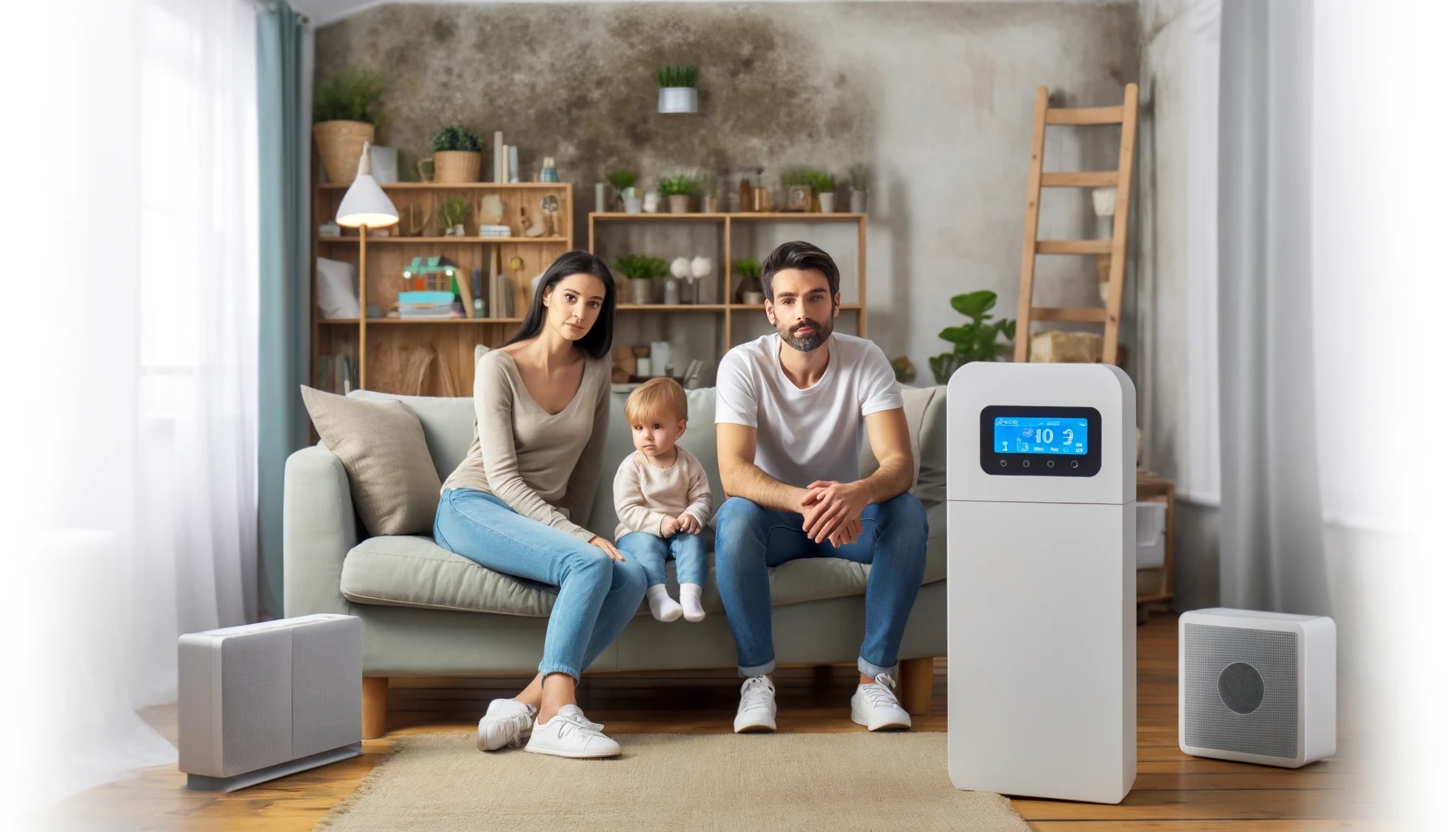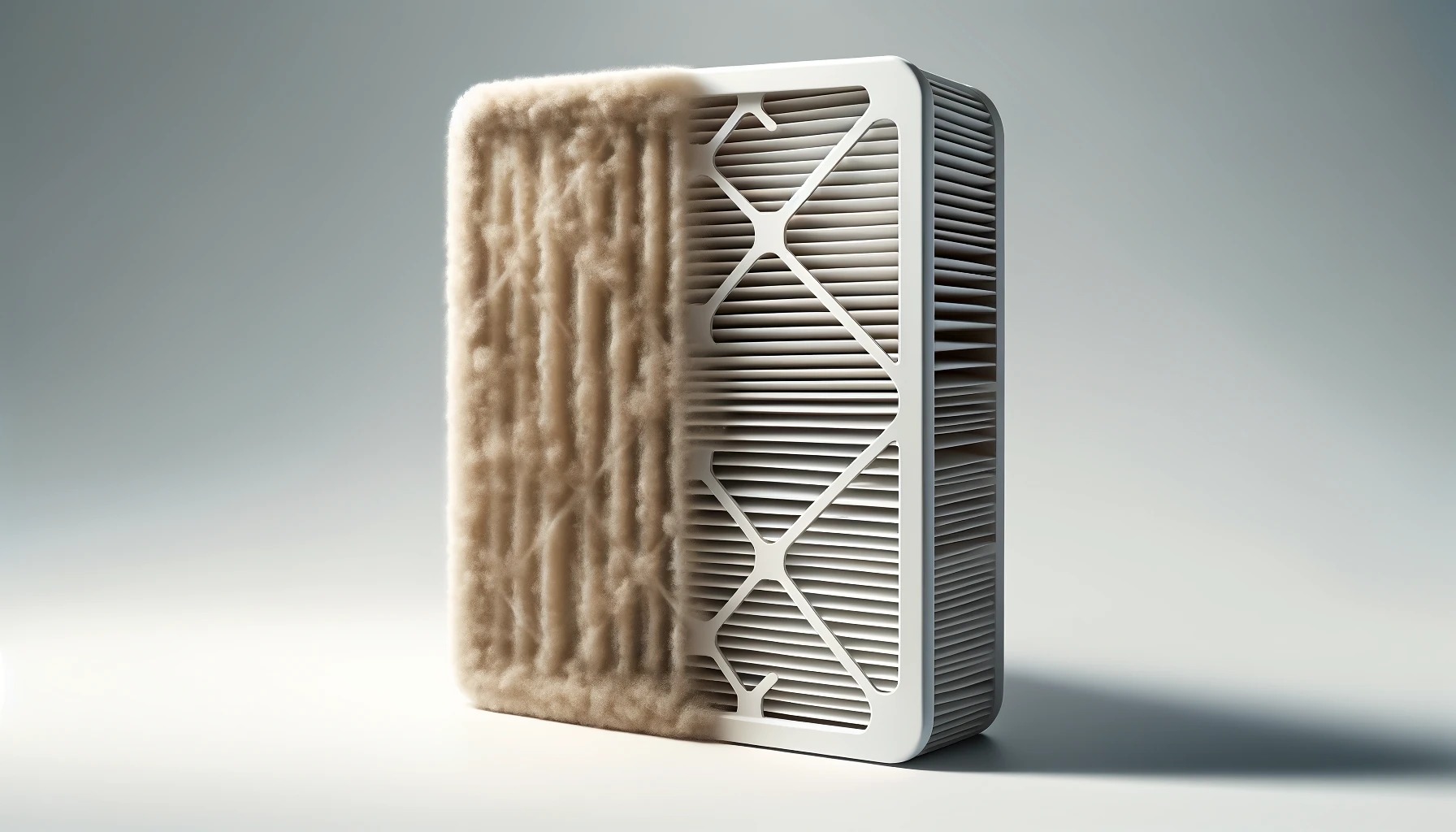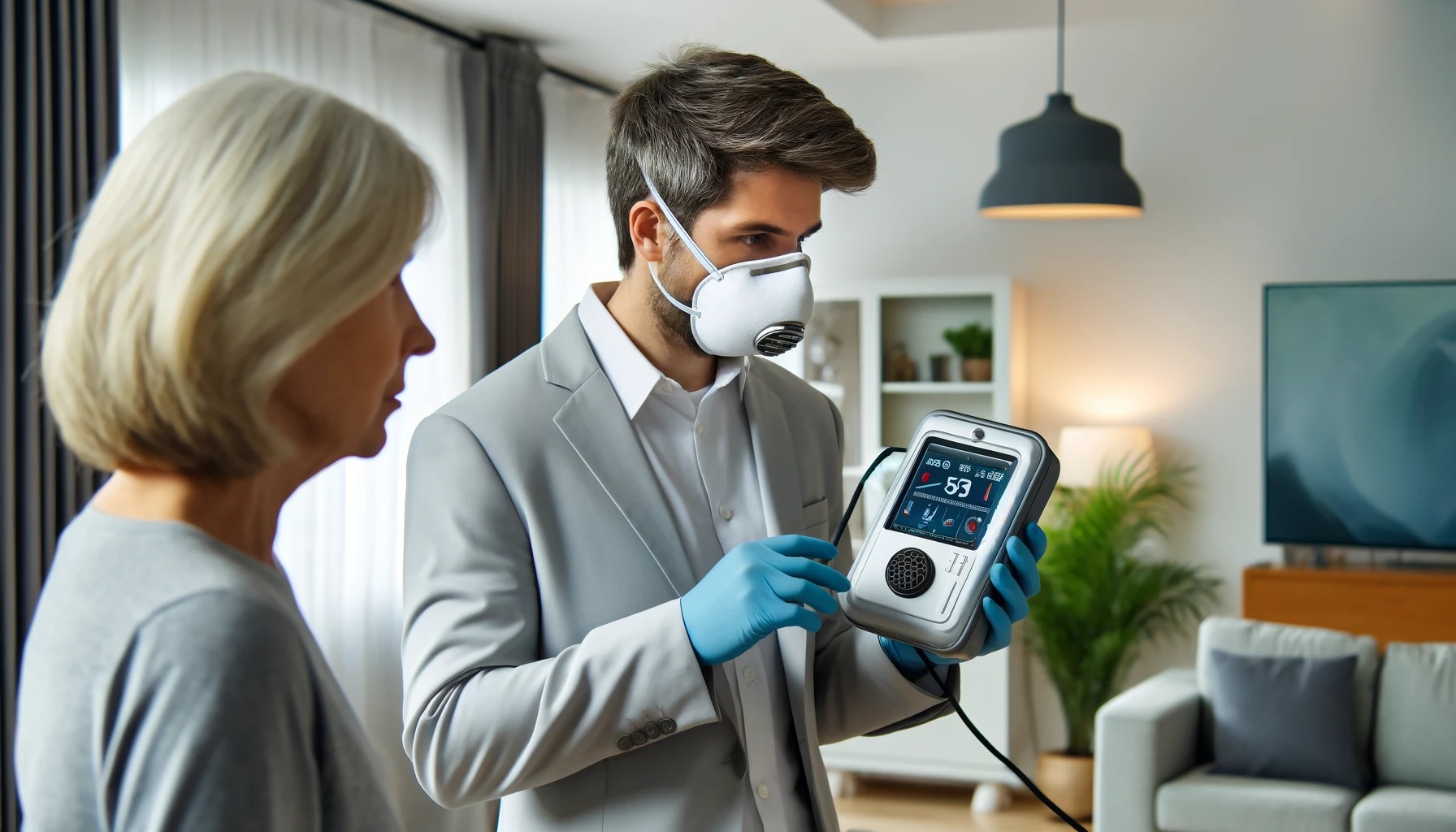April 9, 2024
Signs Your Home Needs Air Quality Testing

Identifying the need for air quality testing in your home is crucial for ensuring a healthy living environment. Various indicators might suggest that it’s time to assess the air you breathe indoors. From persistent health symptoms among residents to visible mold growth or an unexplained musty odor, these signs should not be ignored. If your home has recently undergone renovations or if you’re moving into an older property, testing becomes even more essential. Understanding these signals can help protect your family’s health and well-being by addressing potential air quality issues promptly.
To find a professional air quality testing service in your area, visit our ‘find air quality testing near me‘ page for local assistance.
Recognizing Poor Air Quality Signs

Dust Accumulation
Dust buildup is a clear sign. If you notice dust particles on surfaces soon after cleaning, it’s a red flag. This indicates air filters might be clogged or inefficient.
It’s crucial to regularly check and replace air filters to combat this issue.
Mold Growth
Mold thrives in damp environments. Seeing mold on walls or ceilings suggests high humidity levels. Airborne mold spores can severely affect health, especially for asthma sufferers.
Addressing leaks and using dehumidifiers can help maintain optimal humidity and prevent mold.
Unusual Odors
Strange smells often point to hidden pollutants. These odors may come from chemicals or decaying materials within the home. They signal the presence of VOCs or other harmful substances.
Investigating and eliminating these sources is essential for improving air quality.
Since mold growth is a significant indicator of poor indoor air quality, employing professional mold testing services is a crucial step towards ensuring your home’s health.
Humidity Changes
Both high and low humidity levels are problematic. Dry air can irritate the skin and respiratory system, while excessive moisture promotes mold growth. Monitoring humidity helps pinpoint potential air quality issues.
Using humidifiers or dehumidifiers can balance indoor humidity, enhancing comfort and health.
Evaluating Health Symptoms
Respiratory Issues
People often notice respiratory problems first. Asthma attacks may happen more often. Allergy symptoms like sneezing or coughing can also increase. These signs suggest the air in your home might not be clean.
Poor air circulation is a key issue here. It lets harmful particles stay in your home’s air. This makes breathing problems worse for everyone, especially those with asthma.
Headaches and Fatigue
Frequent headaches are another sign. Dizziness and feeling tired all the time can also mean the air quality is bad. These symptoms could point to a serious health risk.
When you feel these things often, it’s likely not just stress from work. It could be that the air inside your home has harmful substances. Testing the air can help find out if this is true.
Skin Conditions
Poor indoor air affects your skin too. You might see more rashes or feel your skin getting dry. This shows that something in the air is irritating your skin.
Skin issues like these are often overlooked as signs of bad air quality. But they are important clues that should not be ignored. They tell us our homes need testing to make sure the air is safe.
Monitoring Carbon Monoxide and Radon
Carbon Monoxide
Installing carbon monoxide detectors in your home is crucial. Place them near heating systems for effective monitoring. These devices alert you when carbon dioxide levels reach a dangerous point. High concentrations can lead to serious health issues.
Carbon monoxide is invisible and odorless. Without detectors, it’s nearly impossible to know its presence. Early detection prevents long-term exposure, safeguarding your family’s health.
Radon Testing
Radon is another invisible threat that comes from the ground and certain building materials. It can accumulate in basements and ground-floor rooms. Using radon detection kits helps identify elevated radon levels.
Testing for radon is essential because long-term exposure increases the risk of lung cancer. The kits provide accurate readings, highlighting if your home has dangerous levels of radon.
Health Risks
Both gases pose significant health risks with prolonged exposure. They can lead to lung cancer among other illnesses. Being proactive by monitoring these gases ensures a safer living environment.
Understanding the dangers associated with carbon monoxide and radon emphasizes the need for regular air quality testing. Protect yourself and your loved ones by staying informed and taking action.
The Role of Air Purifiers
HEPA Filters
Air purifiers with HEPA filters play a crucial role in capturing tiny particles. They trap dust, pollen, and pet dander. This makes the air in your home cleaner and safer to breathe.
These devices pull household air through the filter. They catch harmful particles. Your home feels fresher as a result.
Activated Carbon
Purifiers with activated carbon filters are also vital. They reduce volatile organic compounds (VOCs) and odors. These can come from cleaning products and other sources in your home.
Activated carbon works by absorbing gases on a molecular level. This includes smells from the kitchen or chemicals from products you use.
Maintenance Tips
For air purifiers to work well, they need regular care. Check and replace filters as recommended by the manufacturer. This ensures they continue improving indoor air quality effectively.
Clean air pumps and other parts of the purifier too. This helps keep the device running smoothly.
Using Digital Air Quality Monitors
Real-Time Data
Digital air quality monitors offer real-time data on various pollutants. These include particulate matter and VOCs (Volatile Organic Compounds).
Owners can see the air quality in their homes at any time. This helps identify if and when they need to take action. For example, increasing ventilation or using air purifiers discussed previously.
Comprehensive Overview
Choosing the right monitor is crucial. Some monitors provide insights into humidity and temperature. This gives a more comprehensive overview of indoor air quality (IAQ).
Monitoring these factors is important for comfort and health. It can also help prevent mold growth by maintaining optimal humidity levels.
Indoor vs Outdoor
It’s useful to compare indoor air quality readings with outdoor levels. This shows how effective your air purification efforts are.
If indoor levels are consistently higher than outdoor, it might indicate a problem indoors. Actions like improving ventilation or checking for sources of pollution may be necessary.
Professional Air Quality Evaluation Methods

Expert Analysis
Seeking professional help is crucial for a comprehensive air quality assessment. Experts use advanced tools to detect pollutants that digital monitors might miss.
Professionals can identify specific pollutants, such as volatile organic compounds (VOCs), carbon monoxide, and particulate matter. They collect air samples and analyze them in labs. This process helps pinpoint the exact sources of pollution in your home.
Mold Detection
One key benefit of professional testing is finding hidden dangers like mold or asbestos. These substances can cause health issues but are not always visible.
Experts have the skills to spot signs of mold and asbestos. They know where these hazards tend to hide. After identification, they can advise on the best removal methods.
Targeted Solutions
Professional evaluations lead to targeted improvements in air quality. They provide detailed reports on your home’s air quality issues.
With these reports, you can make informed decisions on how to improve air quality. Whether it’s upgrading ventilation systems or removing specific pollutants, expert advice guides you.
Understanding Different Air Pollutants
Common Pollutants
Indoor air quality can suffer due to various pollutants. Particulate matter and volatile organic compounds (VOCs) are common. So are biological contaminants.
Particulate matter comes from many sources. It includes dust, pollen, and smoke. VOCs often come from paints and cleaning products. Biological contaminants include mold and pet dander.
Sources
Pollutants enter our homes in several ways. Some come from outside air. Others come from inside activities or materials.
Building materials can release pollutants over time. Cleaning products, too, add to indoor pollution. Even personal care items can contribute.
Health Impacts
Long-term exposure to these pollutants can harm health. It can cause respiratory issues and worsen allergies. Some pollutants even have links to more serious conditions.
Understanding the sources helps in reducing exposure. It guides effective mitigation strategies.
Importance of Regular Air Quality Testing
Pollution Detection
Detecting new pollution sources is vital. Regular air quality testing spots these quickly. It helps homeowners act fast to reduce exposure.
Tests might reveal hidden mold or rising levels of harmful chemicals. These issues can worsen over time if unnoticed. Early detection through testing saves health and money.
Strategy Adjustment
Environmental conditions change often. So should air purification strategies. Regular testing provides the data needed for this adjustment.
It shows if current methods are working or if new approaches are necessary. This ensures the air in your home stays clean and safe for everyone.
Health Maintenance
Consistent monitoring is key to a healthy home environment. It prevents long-term exposure to pollutants that can cause serious health issues.
Regular air quality testing ensures the living space remains safe for all family members, especially those with respiratory conditions or allergies. It’s an essential part of maintaining a healthy lifestyle.
Final Remarks
Recognizing the signs that a home needs air quality testing is crucial for maintaining a healthy living environment. Poor air quality can lead to a variety of health symptoms, making it essential for individuals to monitor their surroundings for carbon monoxide, radon, and other pollutants. The use of air purifiers and digital monitors can aid in this process, but professional evaluation methods offer the most comprehensive assessment. Regular testing plays a significant role in understanding and mitigating the risks associated with different air pollutants. It ensures the well-being of occupants by providing a clear picture of the air quality within a home. Therefore, individuals should consider these signs as indicators to take action and seek professional air quality testing services. This proactive approach not only protects health but also contributes to a safer, more comfortable living environment.
If you’re concerned about the air you and your family breathe, consider exploring residential air quality testing services for a comprehensive evaluation.
Frequently Asked Questions
What are the common signs that my home needs air quality testing?
Poor air quality in your home can manifest through various signs, including persistent odors, increased allergy or asthma symptoms among residents, and visible mold growth. These indicators suggest the need for immediate air quality testing.
How can health symptoms indicate poor indoor air quality?
Health symptoms such as frequent headaches, dizziness, fatigue, and respiratory issues when indoors can indicate poor air quality. If these symptoms improve upon leaving the house, it’s a strong sign that your indoor environment may require evaluation.
Why is monitoring carbon monoxide and radon important for air quality?
Carbon monoxide and radon are colorless, odorless gases that can pose serious health risks, including lung cancer from radon exposure and fatal poisoning from carbon monoxide. Monitoring levels of these gases is crucial for maintaining safe indoor air quality.
Can air purifiers improve the quality of indoor air?
Air purifiers can significantly improve indoor air quality by removing contaminants such as dust, pollen, pet dander, and smoke particles. However, their effectiveness depends on factors like the type of purifier and the specific pollutants present in your home.
How do digital air quality monitors work?
Digital air quality monitors assess the level of pollutants in your indoor environment by measuring various parameters such as particulate matter (PM2.5), volatile organic compounds (VOCs), humidity, and temperature. This data helps identify pollution sources and evaluate air purification efforts.
What methods do professionals use to evaluate air quality?
Professionals employ a variety of methods to evaluate indoor air quality, including visual inspections for mold or moisture issues, sampling for biological contaminants like bacteria or pollen, and using advanced instruments to detect chemical pollutants and gases.
Why is regular testing of home air quality important?
Regular testing helps identify new sources of pollution or changes in the indoor environment that may impact air quality over time. It ensures that preventive measures remain effective and that the living space remains healthy and safe for its occupants.




